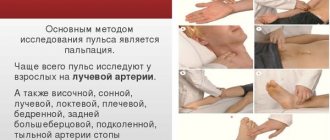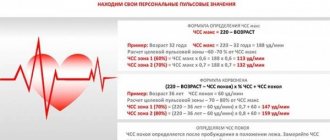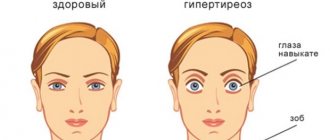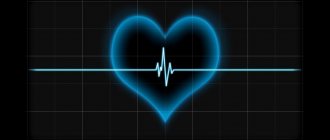Normal heart rate in an adult
In medicine, there are specific values for this indicator; the heart rate norm for adults is formed depending on the person’s age and state of health. The pulse is a vibration of the walls of blood vessels that occurs due to contraction of the heart muscle. Its meaning will be different for different states. This allows doctors, knowing what pulse is considered normal, to assess the work of the heart.
The intervals between contractions (pulsations) in a healthy person are always the same; uneven beats are a symptom of some kind of disturbance in the functioning of the human body. The average for an adult is 60-90 beats per minute, but there are situations in which a short-term change is observed. The main factors include:
- exercise stress;
- stress;
- age;
- increased body temperature;
- hormonal release.
Pulse is normal for women
Due to the physiological characteristics of the female body, their heart rate is different from that of men. As a rule, the score for girls is 7-10 strokes higher than for boys, but this is not a deviation. The normal pulse rate in women, provided that she is completely healthy and is in a state of relative rest, is:
| Age | Min-max | Average | Normal blood pressure (systol/diastole) |
| Up to 50 | 60/80 | 70 | 116-137/70-85 |
| 50-60 | 65/85 | 75 | 140/80 |
| 60-80 | 70/90 | 80 | 144-159/85 |
Pulse is the norm according to age in men
The normal score for guys is lower than for women by an average of 7-9 beats. A distinction should be made between the acceptable values of adult men and children of boys. Pulse measurement should be carried out taking into account what the person was doing before, how long ago he ate, and the time of day. Each of these factors can cause higher or lower rates. Below is a table showing what pulse is considered normal in men, provided that he is completely healthy:
| Age | Min-max | Average | Normal blood pressure (systol/diastole) |
| Up to 50 | 60/80 | 70 | 123-135/76-83 |
| 50-60 | 65/85 | 75 | 142/85 |
| 60-80 | 70/90 | 80 | 142/80-85 |
Heart rate recovery after exercise
The natural pulse rhythm ranges from 60-100 beats/min. However, during training, during stressful situations, its norm changes.
This rhythm is very important for athletes, especially after training, every other day. Speaking in the language of athletes, its level should be within 50-60 beats/min.
An indicator of a good workout is a heart rate level of 60-74 beats/min. Range up to 89 beats/min – average. However, anything above 910 beats/min is considered a critical indicator, with which athletes are not recommended to start training.
How long does it take to recover?
It usually takes about 30 minutes to restore the rhythm. It is considered natural to rest the body for no more than 15 minutes so that the pulse returns to its pre-workout state.
Reasons for long-term high heart rate
Physical activity is stress for the entire human body. It requires a lot of energy. Every muscle movement costs energy and oxygen.
The delivery of these resources is carried out by blood circulation, which causes an increased rate of heart work.
Normally, the pulse causes the heart muscles to contract faster. If we talk about any specific diseases, then this is tachycardia. Pathology when the pulse crosses the mark of 120 beats/min.
If there is a slow heartbeat during and after training, this is bradycardia.
Athletes suffer from a slow rhythm due to excessive training.
If the pulse is uneven, then this is sinus arrhythmia. The frequency, as a rule, in this case varies from normal to increased.
If a chaotic pulse with a rapid heartbeat is observed, then this is atrial fibrillation, and each attack leads to disruption of blood flow. Such a violation irreversibly leads to oxygen starvation.
Depending on your age, work, lifestyle, and pace of training, your heart rate changes. When under load, it becomes more frequent, involving physiological changes. Typically, an increase in physical activity is directly proportional to an increase in heart rate.
Therefore, athletes use heart rate calculations, which are also important for untrained people during various training sessions and depending on age, weight, etc.
Normal heart rate in a child
The child’s body grows very quickly, so indicators of its condition are measured more often. A child’s normal heart rate changes with increasing height and weight. For example, normal indicators decrease after 1 month of a child’s life. For teenagers (starting from 12 years old), the values are already the same as for an adult. The following normal values are recognized in a calm state:
| Age | Min-max | Average | Normal blood pressure (systol/diastole) |
| 0-1 month | 110-170 | 140 | 60-80/40-50 |
| From 1 month up to a year | 102-162 | 132 | 100/50-60 |
| 1-2 years | 94-155 | 124 | 100-110/60-70 |
| 4-6 | 86-126 | 106 | |
| 6-8 | 78-118 | 98 | 110-120/60-80 |
| 8-10 | 68-108 | 88 | |
| 10-12 | 60-100 | 80 | 110-120/70-80 |
ECG elements
Several consecutive teeth are combined into intervals. Each tooth has a specific meaning, marking and classification:
- P - designation of the tooth, which records how much the atria have contracted;
- Q, R, S - 3 teeth that record the contraction of the ventricles;
- T - shows the degree of relaxation of the ventricles;
- U is not always a fixed tooth.
Q, R, S are the most important indicators. Normally, they go in order: Q, R, S. The first and third tend downward, as they indicate excitation of the septum. The Q wave is especially important, since if it is widened or deepened, this indicates necrosis of certain areas of the myocardium. The remaining teeth in this group, directed vertically, are designated by the letter R. If their number is more than one, this indicates pathology. R has the greatest amplitude and is best distinguished during normal heart function. In case of illness, this tooth stands out weakly and is not visible in some cycles.
A segment is an interdental straight isoline.
The maximum length is fixed between the ST and PQ teeth. Impulse delay occurs in the atrioventricular node. A straight PQ isoline appears. An interval is considered to be a section of a cardiogram containing a segment and waves. The values of the QT and PQ intervals are considered to be the most responsible. Table of normal values for adults
| Index | Norm, seconds |
| Q, R, S | 0,06—0,1 |
| P | 0,01—0,11 |
| Q | 0,03 |
| T | 0,12—0,28 |
| PQ | 0,12—0,2 |
| Heart rate | 60—90 |
Decoding the results

Determination of the main indicators of an ECG recording is carried out according to the following scheme:
- Conductivity and rhythm are analyzed. The doctor has the opportunity to calculate and analyze the regularity of heart contractions using the ECG. Then he calculates heart rate, finds out what caused the excitation and evaluates conductivity.
- It is determined how the heart is rotated relative to the longitudinal, transverse and anteroposterior axes. The electrical axis is determined in the anterior plane, as well as the rotation of the heart muscle around the longitudinal and transverse lines.
- The P wave is calculated and analyzed.
- The doctor analyzes the QRST complex in the following order: QRS complex, size of the RS-T segment, position of the T wave, duration of the Q-T interval.
Normally, the segments between the tops of the R waves of adjacent complexes should correspond to the intervals between the P waves. This indicates a sequential contraction of the heart muscle and the same frequency of the ventricles and atria. If this process is disrupted, arrhythmia is diagnosed.
Pulse when walking is normal
This value is affected by normal, sports or therapeutic walking. Such walks are prescribed by many doctors as a prevention and treatment of vascular diseases. Heart rate characteristics will vary depending on the intensity of the exercise and age. This is the most gentle sport that does not have an additional effect on the joint or cardiovascular system.
A normal walking heart rate for an adult should be about 100 beats per minute. For an untrained beginner, the value can reach up to 120, which indicates that the patient should not do long walks for the time being. By year, the norm for walking is:
- 25 years – 140;
- 45 years old – 135;
- 70 years – 110.

Normal heart rate at rest
This indicator helps to further track any changes that will occur to the person. A normal resting heart rate is the reference value for heart function. The heart rate may vary depending on the time of day (it is higher in the evening) and body position. To create a schedule, you need to take a sitting measurement every day at 10 am. The heart rate of an adult at rest is:
- for men – 60-80;
- for women – 68-90;
- in older people – 65;
- in adolescents – 80;
- children 1-2 years old – 100;
- for the newborn – 140.
Normal heart rate when running
This is one of the most intense options for stress on the cardiovascular system. A normal heart rate when running corresponds to the set goal. For example, to lose weight, a person must be in the upper sector of the maximum permissible heart rate while jogging. If the goal is only to strengthen blood vessels, then the indicator should be at 60% of the maximum. For a healthy person, the maximum value is calculated using a simple formula: 200 minus your age.
For example, for a 25-year-old guy, the maximum permissible heart rate without damage to the body will be 185 beats. For intense fat burning, the norm will be 165-170 beats. If we are only talking about increasing endurance, then the heart rate should be 140-150 beats per minute. At normal pressure, these indicators will be acceptable and will not cause the development of bradycardia or tachycardia.

Pulse zones during cardio
There are several heart rate zones, each of which includes certain load requirements. Depending on which type you choose, you can achieve certain results.
Aerobic
This zone involves training at an intensity of 70-80% of your maximum heart rate.
Attention! Exercising in this mode increases endurance , but also increases the load on the heart , so it is important to correctly calculate the optimal heart rate for the body. By training in this zone, a person increases not only functional capabilities, but also increases the arteriovenous oxygen difference.
From training in this zone, pulmonary ventilation intensifies, the size and number of blood vessels increases, and accordingly a person pumps the tidal volume of the lungs. Moreover, stroke volume increases and resting heart rate decreases.
The respiratory and cardiovascular systems improve and at the same time the functional state of the heart improves as well as its size increases. When training at this pace, 50% of carbohydrates and fats and less than 1% of proteins are burned . It is worth noting that with the intensity of exercise, the number of calories burned increases.
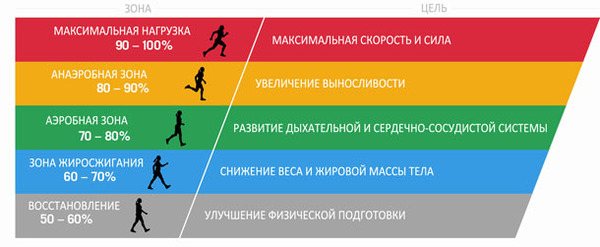
Photo 1. The main goals of training in aerobic and other pulse zones. On the left is the percentage of your maximum heart rate.
Fitness area
It lies within 60-70% of the maximum heart rate. This training for burning concrete is no different from the “heart zone”, however, the processes inside the body are different.
Reference! Research shows that when you exercise, the body converts fat into muscle. And also due to increased intensity, more calories are burned. When exercising in this zone, 85% of fats, 5% of proteins and 10% of carbohydrates are burned.
Anaerobic
The next zone is or anaerobic zone It is located within 80-90% of the maximum heart rate.

Oxygen consumption improves during this workout. This means that the state of the respiratory and cardiovascular systems improves, tolerance to lactose increases, due to which the body’s endurance increases.
A person gets rid of 85% of carbohydrates, 15% of fats and less than 1% of proteins.
Maximum heart rate
The last area is also called the red line zone. It is located at 90-100% of the maximum heart rate. This type of training burns 90% of carbohydrates, only 10% of fats and less than 1% of proteins.
Attention! High intensity training is not suitable for beginners , as the endurance must be sufficient to withstand 20 minutes at this pace. For a trained person, it is recommended to work in the maximum heart rate zone during interval exercise.
Normal heart rate during pregnancy
During this period, all girls experience an increase in pulse waves, which is the norm. Carrying a fetus creates additional stress on the heart, which leads to more active blood pumping. This fact could not but affect the normal pulse during pregnancy. The number of pulse waves increases by 10-15, the value will remain at the level of 110 heartbeats per minute. If a girl plays sports, her heart rate can rise up to 140.
An increase in average heart rate will be observed in the second trimester. Maximum values are recorded between 27 and 32 weeks, decreasing 4 weeks before birth. The average value during this period will be 70-80, but in the second half of pregnancy the value may rise to 85-90. In some cases, due to the additional load, the heart rate increases in the supine position to 120.
Pulse during exercise is normal
A person should initially record the value at rest. It should be measured by feeling a vein in the arm or an artery in the neck. This will help you calculate your normal heart rate during exercise. The intensity of activity can be different, for example, when walking, the heart rate does not rise above 100, but running raises the heart rate much higher.
The normal indicator for a person must be calculated individually, but there are average indicators that can be taken as a starting point for comparison, for example:
- at a heart rate of 100-130, the load for you is relatively small;
- 140-150 – average training intensity;
- 170-190 are maximum permissible values that cannot be maintained for a long time.

Pulse after eating is normal
Eating affects blood circulation, the heart increases the flow to the stomach, so the heart rate increases slightly. On average, fluctuations from rest are 5-10 beats. Some people experience signs of bradycardia or tachycardia after eating, which indicates poor circulation or heart disease. Pulse after eating - the norm will be violated if:
- diabetes mellitus;
- obesity;
- myocardial pathology;
- pathological processes of the stomach;
- abnormalities in the functioning of the thyroid gland.
Normal heart rate during sleep
Heartbeat values differ between day and night. The normal heart rate during sleep is almost one and a half times lower than the daytime level. There is a sleep phase when heart rate reaches its lowest point - 4 am. For this reason, the highest risk of heart attack occurs in the early morning. This happens due to the activity of the vagus nerve, which inhibits the functioning of the heart muscle at night. Decreased pulse waves are also observed in the first hours after awakening.
Keep in mind that for a complete check you need to measure the indicators on both hands. The heart rate should be the same; if there are differences, this indicates the presence of circulatory disorders and obstructed blood flow to the limb. This phenomenon occurs when:
- stenosis of the mouth of the peripheral artery;
- aortic stenosis;
- arthritis.
sovets.net
How to calculate your heart rate during physical activity?
You can calculate the normal heart rate during training using the following formula: 220 - the person’s age multiplied by the training intensity indicators. Load levels (%):
- 50-60 - extremely easy warm-up;
- 60-70 - light exercise aimed at burning fat and increasing endurance;
- 70-80 - medium intensity, promotes the growth of stroke volume of the heart;
- 80-90 - intense training that promotes the growth of lean body mass;
- 90-100 is the maximum limit for developing strength and speed.
Example: a 30-year-old man. 220 - 30 = 190 With moderate intensity training: 190 x 0.7 = 133 190 x 0.8 = 152 Normal: from 133 to 152. With intense training: 190 x 80 = 152 190 x 90 = 171 Heart rate from 152 to 171 .
What is the norm?
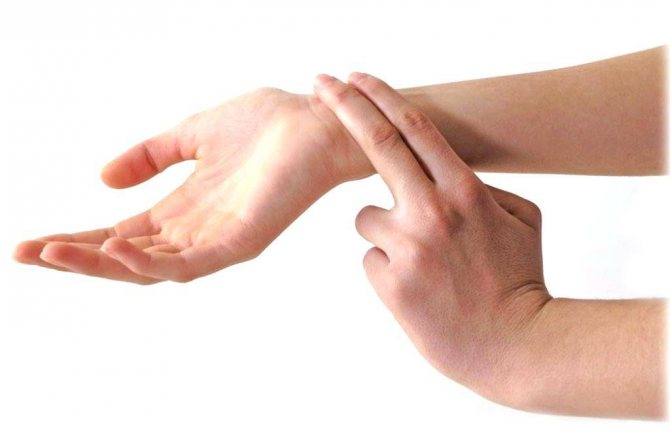
The normal heart rate during exercise in a healthy person increases from 50 to 70%, but should not exceed the latter limit. The following factors affect heart rate:
- person's age;
- floor;
- weight and height;
- endurance;
- chronic diseases;
- food intake (alcohol);
- emotional condition.
What indicators does the heart rate reach during heavy physical activity?
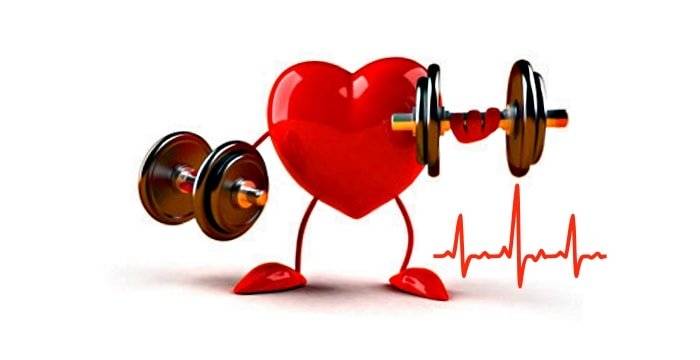
With heavy load, heart rate reaches from 80 to 95%. Calculation of the permissible limit is calculated using the formula: 220 - the person’s age. Example: a 30-year-old man. 220-30=190. 190 x 0.80= 152 - lower limit 190 x 0.95= 180.5 - upper limit Conclusion: During intense physical activity, a man's heart rate should vary from 152 to 180.5 beats per minute.
Optimal heart rate for fat burning: an individual approach
The work of the heart during physical exercise depends on the degree of training of a person, his age and gender. To determine the optimal heart rate for fat burning, there is the Karvonen formula, which takes into account most of these parameters. Using it, you can calculate the value of the maximum permissible heart rate during sports. Using this indicator, pulse zones corresponding to different types of load are determined.
There are several modifications of the formula:
- Simplified. According to it, the maximum heart rate during training is: 220 - a person’s age.
- Taking into account gender. It is calculated separately for representatives of different sexes. For men the indicator is: 220 minus age, for women: 220 minus age and minus 6.
- Refined. It uses the average number of heartbeats at rest: 220 minus age and minus resting heart rate.
Online calculators have been developed for convenience. You can enter a person’s data into them, and they will show the maximum heart rate, calculated in various versions using the Karvonen method.
The rate of fat burning depends on what percentage of the maximum possible heart rate is during training. According to the values of this indicator, several pulse zones are distinguished:
- Recovery - heart rate reaches 50–60% of the maximum allowable. There is a general improvement in well-being, weight loss is minimal.
- Fat Burning Zone – is in the range of 60-75% of your individual maximum heart rate. Working in this mode is most effective for losing weight.
- Threshold (cardio training) - takes place in the range of 75–80% of the maximum heart rate. Physical activity at this heart rate also allows you to actively reduce body weight due to adipose tissue.
- Intense - heart rate is 80–95% of maximum. Under these conditions, the body actively builds muscles. Training at this heart rate is not suitable for losing extra pounds.
- Maximum - the number of heartbeats reaches a maximum. In this case, anaerobic energy supply mechanisms are activated, and fat is not consumed.
The optimal heart rate for weight loss is 60–80% of the maximum value, calculated individually. Using the simplified Karvonen formula, it ranges from 90 to 170 beats per minute. The most effective exercises are at the same pace, lasting at least 40 minutes.
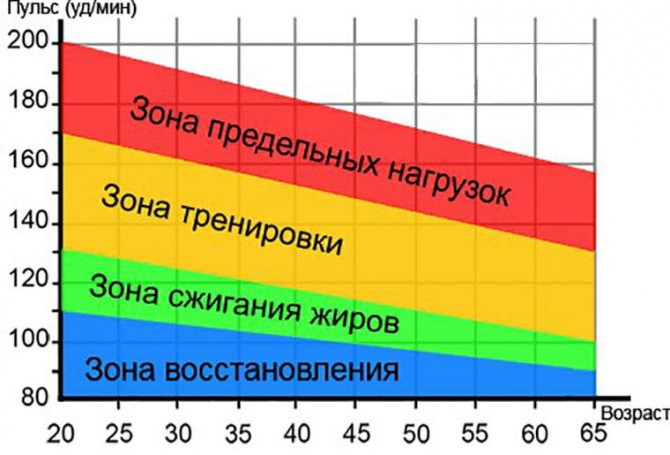
Pulse zones at different ages
In sports medicine, there are special tests that allow you to more accurately determine target heart rate values for each zone. In addition to characteristics such as gender and age, they take into account the degree of physical fitness of a particular person and the ability of the functional systems of his body to adapt to stress.
Online calculator
The calculator for measuring heart rate during physical activity will allow you to determine:
- heart rate;
- fat burning;
- heart rate norm by age category;
- heart rate zones during training of varying intensity;
- maximum heart rate.
Using an online calculator is as easy as pie. Enter the following personal parameters: resting heart rate and age, then view heart rate zone maps based on the most popular methods.
diet-diet.ru
Why does the heart rate increase?
All organs and tissues of a living organism need to be saturated with nutrients and oxygen. It is on this need that the work of the cardiovascular system rests - the blood pumped by the heart saturates the organs with oxygen and returns to the lungs, where gas exchange occurs. At rest, this occurs at a heart rate from 50 (in trained people) to 80-90 beats per minute.
With active movement, the need for oxygen in all organs increases sharply. This is why your heart rate increases after exercise.
The heart receives a signal that it needs more oxygen and begins to work at an accelerated pace to ensure the required volume of oxygen is supplied.
Within normal limits
The normal heart rate of an adult is 60-80 beats per minute; the higher is called tachycardia, the lower is called bradycardia. If pathological conditions become the cause of such fluctuations, then both tachycardia and bradycardia are regarded as a symptom of the disease. However, there are other cases. Probably, each of us has ever encountered a situation when the heart is ready to jump out from an excess of feelings and this is considered normal.
As for the rare pulse, it is mainly an indicator of pathological changes in the heart.

The normal human pulse changes in various physiological states:
- It slows down in sleep, and generally in a supine position, but does not reach real bradycardia;
- Changes during the day (at night the heart beats less frequently, after lunch the rhythm accelerates), as well as after eating, alcoholic drinks, strong tea or coffee, some medications (heart rate increases in 1 minute);
- Increases during intense physical activity (hard work, sports training);
- Increases from fear, joy, anxiety and other emotional experiences. Rapid heartbeat caused by emotions or intense work almost always goes away quickly and on its own as soon as the person calms down or stops vigorous activity;
- The heart rate increases with increasing body and environmental temperature;
- It decreases over the years, but then, in old age, it increases slightly again. In women with the onset of menopause, in conditions of reduced estrogen influence, more significant upward changes in pulse may be observed (tachycardia caused by hormonal disorders);
- Depends on gender (the pulse rate in women is slightly higher);
- It differs in especially trained people (slow pulse).
Basically, it is generally accepted that in any case, the pulse of a healthy person is in the range from 60 to 80 beats per minute, and a short-term increase to 90 - 100 beats / min, and sometimes up to 170-200 beats / min is regarded as a physiological norm, if it arose due to an emotional outburst or intense work activity, respectively.
Heart rate deviations from the norm - a symptom of a disease or an individual trait?
Heart rate is an indicator that does not have the most strict normal criteria: permissible heart rate values in adults are a wide range from 60 to 90 beats per minute. Both moderate bradycardia (decrease in heart rate) and tachycardia (increase in heart rate) can be normal if a person feels normal. However, there are situations when an increase or decrease in heart rate is not the norm:
- Heart rate is more than 100 beats per minute in the absence of increased physical activity and stress;
- Heart rate less than 50-55 (if you are a trained athlete, then this indicator may be the norm for you);
- tachycardia 5 minutes or more after completion of physical labor or exercise;
- if the pulse is difficult to palpate, this may be a sign of heart failure.
Heart rate is affected by obesity, lack of exercise, chronic stress and inadequate sleep patterns.
https://www.youtube.com/watch?v=ytaboutru
If the heart rate is higher than normal for a long time, this means that the heart is working at the limit of its capabilities. Clench your fist tightly and hold it like that for some time. Soon you will feel your muscles getting tired. The same thing happens to the heart when it works in an intense mode.
Men, women, athletes
Heart rate (heart rate) is influenced by indicators such as gender and age, physical fitness, a person’s occupation, the environment in which he lives, and much more. In general, differences in heart rate can be explained as follows:
- Men and women react to different events to varying degrees (most men are more cold-blooded, women are mostly emotional and sensitive), so the heart rate of the weaker sex is higher. Meanwhile, the pulse rate in women differs very little from that in men, although, if we take into account the difference of 6-8 beats/min, then males lag behind, their pulse is lower.
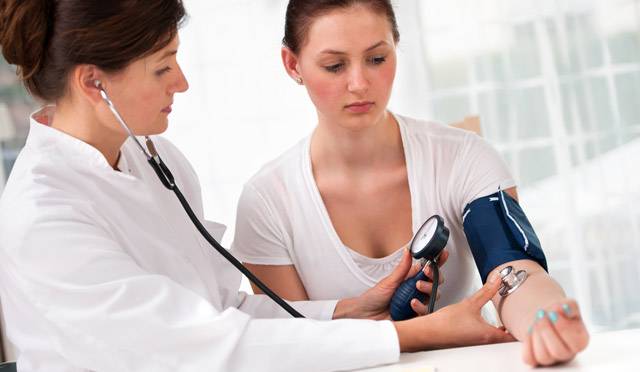
- Out of competition are pregnant women , whose slightly elevated heart rate is considered normal and this is understandable, because while carrying a child, the mother’s body must fully meet the need for oxygen and nutrients for herself and the growing fetus. The respiratory organs, circulatory system, and heart muscle undergo certain changes to perform this task, so the heart rate increases moderately. A slightly elevated heart rate in a pregnant woman is considered normal if, besides pregnancy, there is no other reason for its increase.
- A relatively rare pulse (somewhere near the lower limit) is observed in people who do not forget about daily physical exercise and jogging, who prefer active recreation (swimming pool, volleyball, tennis, etc.), in general, who lead a very healthy lifestyle and take care behind your figure. They say about such people: “They are in good sports shape,” even if by the nature of their activity these people are far from professional sports. A pulse of 55 beats per minute at rest is considered normal for this category of adults, their heart simply works economically, but in an untrained person this frequency is regarded as bradycardia and serves as a reason for additional examination by a cardiologist.
- The heart works even more economically in skiers, cyclists, runners, rowers and adherents of other sports that require special endurance; their resting heart rate can be 45-50 beats per minute. However, prolonged intense stress on the heart muscle leads to its thickening, expansion of the boundaries of the heart, and an increase in its mass, because the heart is constantly trying to adapt, but its capabilities, unfortunately, are not limitless. A heart rate of less than 40 beats is regarded as a pathological condition; ultimately, the so-called “athletic heart” develops, which often becomes the cause of death in young healthy people.
The heart rate depends somewhat on height and constitution: in tall people, the heart under normal conditions works slower than in short relatives.
What does it represent?
An electrocardiogram measures the electrical activity of the heart muscle, or the potential difference between two points. The mechanism of the heart is described in the following stages:
Enter your pressure
Move the sliders
120
on
80
- When the heart muscle is not contracting, the structural units of the myocardium have a positively charged cell membrane and a negatively charged core. As a result, the ECG machine draws a straight line.
- The conduction system of the heart muscle generates and distributes excitation or electrical impulse. Cell membranes take over this impulse and move from a state of rest to excitation. Cell depolarization occurs—that is, the polarity of the inner and outer membranes changes. Some ion channels open, and potassium and magnesium ions change places throughout the cells.
- After a short period of time, the cells return to their previous state, returning to their original polarity. This phenomenon is called repolarization.
In a healthy person, excitement causes the heart to contract, and recovery relaxes it. These processes are reflected on the cardiogram by teeth, segments and intervals.
How is it carried out?
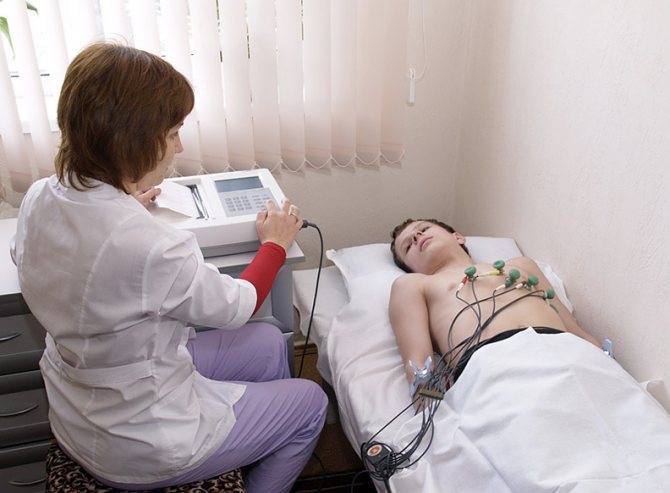
An electrocardiogram is performed as follows:
- The patient in the doctor's office takes off his outer clothing, frees his legs, and lies on his back.
- The doctor cleans the electrode fixation sites with alcohol.
- Cuffs with electrodes are attached to the ankles and certain areas of the arms.
- The electrodes are attached to the body in a strict sequence: a red electrode is attached to the right hand, a yellow electrode is attached to the left. A green electrode is fixed on the left leg, black color refers to the right leg. Several electrodes are fixed on the chest.
- ECG recording speed is 25 or 50 mm per second. During the measurements, the person lies quietly, and the doctor controls his breathing.
Pulse and age
Previously, the fetal heart rate was found out only at 5-6 months of pregnancy (listened to with a stethoscope), now the fetal pulse can be determined using the ultrasound method (vaginal sensor) in an embryo measuring 2 mm (normal - 75 beats / min) and as it grows (5 mm – 100 beats/min, 15 mm – 130 beats/min). During pregnancy monitoring, heart rate usually begins to be assessed from 4-5 weeks of pregnancy. The obtained data are compared with the tabulated norms of fetal heart rate by week:
| Gestation period (weeks) | Normal heart rate (beats per minute) |
| 4-5 | 80-103 |
| 6 | 100-130 |
| 7 | 130-150 |
| 8 | 150-170 |
| 9-10 | 170-190 |
| 11-40 | 140-160 |
By the heart rate of the fetus, you can find out its condition: if the baby’s pulse changes towards an increase, a lack of oxygen can be assumed, but as hypoxia increases, the pulse begins to decrease, and its values less than 120 beats per minute already indicate acute oxygen starvation, which threatens undesirable consequences until death.
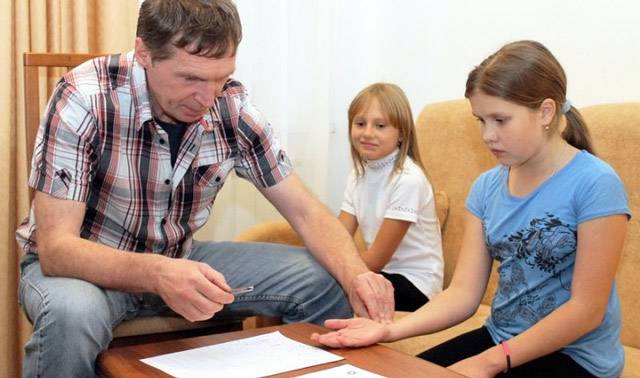
Heart rate norms in children, especially newborns and preschool children, differ markedly from the values typical for adolescence and youth. We, adults, ourselves noticed that the little heart beats more often and not so loudly. To clearly know whether this indicator is within normal values, there is a table of heart rate norms by age , which every person can use:
| Age | Limits of normal values (bpm) |
| newborns (up to 1 month of life) | 110-170 |
| from 1 month to 1 year | 100-160 |
| from 1 year to 2 years | 95-155 |
| 2-4 years | 90-140 |
| 4-6 years | 85-125 |
| 6-8 years | 78-118 |
| 8-10 years | 70-110 |
| 10-12 years | 60-100 |
| 12-15 years | 55-95 |
| 15-50 years | 60-80 |
| 50-60 years | 65-85 |
| 60-80 years | 70-90 |
Thus, according to the table, it can be seen that the normal heart rate in children after a year tends to gradually decrease, a pulse of 100 is not a sign of pathology until almost 12 years of age, and a pulse of 90 until the age of 15. Later (after 16 years), such indicators may indicate the development of tachycardia, the cause of which must be found by a cardiologist.
The normal pulse of a healthy person in the range of 60-80 beats per minute begins to be recorded from approximately 16 years of age. After 50 years, if everything is in order with health, there is a slight increase in heart rate (10 beats per minute over 30 years of life).
Heart rate
One of the equally important characteristics of the pulse is its frequency, to determine which it is necessary to count the number of heart beats in a fifteen-second interval. The result obtained is multiplied by four. In case of irregular rhythm, the number of beats is counted over a one-minute period.
It is important to take into account that at the beginning of the measurement, the subject’s pulse is much faster, but subsequently it slows down.
For each person, heart rate is purely individual. In the absence of pathologies, the resting heart rate is 60-80 beats per minute in males and approximately 70-85 times higher in females.
Heart rate depends on many factors:
- emotional state;
- time of day;
- age;
- states of activity/rest.
Under stressful conditions, the pulse increases significantly. Therefore, after experiencing some kind of emotional shock, inflated heart rate readings are not generally considered correct.
The lowest heart rate is observed in the supine position. While sitting, your heart rate can increase to six beats per minute. In a standing position, heart rate increases by 14 beats.
The highest frequency is observed between eight and twelve in the afternoon. After this, the number of beats per minute decreases, and by three o’clock in the afternoon it begins to increase again, and reaches its maximum at eight o’clock in the evening. A person's heart rate is slowest during sleep.
Heart rate increases when eating hot food or drinks. Cold liquids and food, on the contrary, slow down the pulse. In the summer, the heart rate is higher than in winter.
With physical activity, the indicators increase significantly, and the more intense the load, the greater the frequency of contractions.
During illness, with an increase in body temperature, an increase in heart rate is also observed by an average of 10 beats per minute.
In physically healthy older people, the pulse is usually slower, in contrast to young and middle-aged people.
Pulse rate helps in diagnosis
Diagnosis by pulse, along with temperature measurement, history taking, and examination, belongs to the initial stages of the diagnostic search. It would be naive to believe that by counting the number of heartbeats, one can immediately detect the disease, but it is quite possible to suspect something is wrong and send the person for examination.
Low or high pulse (below or above acceptable values) often accompanies various pathological processes.
High heart rate
Knowledge of the norms and the ability to use the table will help any person distinguish increased pulse fluctuations caused by functional factors from tachycardia caused by disease. “Strange” tachycardia may be indicated by symptoms that are unusual for a healthy body:
- Dizziness, lightheadedness, fainting (indicates that cerebral blood flow is impaired);
- Chest pain caused by impaired coronary circulation;
- Visual disorders;
- Shortness of breath (stagnation in the small circle);
- Autonomic symptoms (sweating, weakness, trembling of limbs).
Causes of rapid pulse and heartbeat can be:
- Pathological changes in the heart and vascular pathology (cardiosclerosis, cardiomyopathy, myocarditis, congenital valve defects, arterial hypertension, etc.);
- Poisoning;
- Chronic bronchopulmonary diseases;
- Hypokalemia;
- Hypoxia;
- Cardiopsychoneurosis;
- Hormonal disorders;
- Lesions of the central nervous system;
- Oncological diseases;
- Inflammatory processes, infections (especially with fever).
In most cases, an equal sign is placed between the concepts of increased pulse and rapid heartbeat, however, this is not always the case, that is, they do not necessarily accompany each other. In some conditions (atrial and ventricular fibrillation and fibrillation, extrasystoles), the number of heart contractions exceeds the frequency of pulse oscillations; this phenomenon is called pulse deficiency. As a rule, pulse deficiency accompanies terminal rhythm disturbances in severe heart damage, the cause of which could be intoxication with cardiac glycosides, sympathomimetics, acid-base imbalance, electric shock, myocardial infarction and other pathology involving the heart in the process.

High pulse and blood pressure fluctuations
Pulse and blood pressure do not always decrease or increase proportionally. It would be wrong to think that an increase in heart rate will necessarily lead to an increase in blood pressure and vice versa. There are also options here:
- A rapid pulse with normal blood pressure may be a sign of vegetative-vascular dystonia, intoxication, and increased body temperature. Folk remedies and medications that regulate the activity of the autonomic nervous system during VSD, antipyretic drugs for fever and medications aimed at reducing the symptoms of intoxication will help reduce the pulse; in general, influencing the cause will remove tachycardia.
- A rapid pulse with high blood pressure can be a consequence of various physiological and pathological conditions (inadequate physical activity, severe stress, endocrine disorders, heart and vascular diseases). Tactics of the doctor and the patient: examination, determination of the cause, treatment of the underlying disease.
- Low blood pressure and high pulse can become symptoms of a very serious health disorder, for example, a manifestation of the development of cardiogenic shock in cardiac pathology or hemorrhagic shock in case of large blood loss, and the lower the blood pressure and the higher the heart rate, the more severe the patient’s condition
. It is clear: not only the patient, but also his relatives will not be able to reduce the pulse, the increase of which is caused by these circumstances. This situation requires immediate action (call “103”).
A high pulse that first appears for no reason can be calmed down with drops of hawthorn, motherwort, valerian, peony, and corvalol (whatever you have on hand). A recurrence of an attack should be a reason to visit a doctor, who will find out the cause and prescribe medications that specifically affect this form of tachycardia.
Low heart rate
The causes of low heart rate can also be functional (about athletes, as discussed above, when a low heart rate with normal blood pressure is not a sign of disease), or stem from various pathological processes:
- Vagal influences (vagus - vagus nerve), decreased tone of the sympathetic nervous system. This phenomenon can be observed in every healthy person, for example, during sleep (low pulse with normal pressure),
- In case of vegetative-vascular dystonia, in the case of some endocrine disorders, that is, in a variety of physiological and pathological conditions;
- Oxygen starvation and its local effect on the sinus node;
- Sick sinus syndrome (SSNS), atrioventricular block;
- Myocardial infarction;

- Toxic infections, poisoning with organophosphorus substances;
- Peptic ulcer of the stomach and duodenum;
- Traumatic brain injuries, meningitis, edema, brain tumor, subarachnoid hemorrhage;
- Taking digitalis medications;
- Side effect or overdose of antiarrhythmic, antihypertensive and other drugs;
- Hypofunction of the thyroid gland (myxedema);
- Hepatitis, typhoid fever, sepsis.
In the vast majority of cases, low pulse (bradycardia) is considered a serious pathology that requires immediate examination to identify the cause, timely treatment, and sometimes emergency medical care (sick sinus syndrome, atrioventricular block, myocardial infarction, etc.).
Low pulse and high blood pressure - similar symptoms sometimes appear in hypertensive patients taking drugs to lower blood pressure, which are simultaneously prescribed for various rhythm disorders, beta blockers, for example.
How to calculate heart rate from an ECG
Calculating heart rate from an ECG involves measuring the distance between successive ventricular complexes R using small cells.
Then you need to find out the speed of the tape; with a standard 50 mm per second, one small cell takes 0.02 seconds. The resulting distance is converted into seconds by multiplying the number of cells by 0.02.
The next stage is to find a match using the table or divide 60 by the length of the RR interval.
This method is not suitable for calculations in case of arrhythmia, then you need to take an ECG in 3 seconds, and count the number of ventricular complexes on the resulting 15 cm segment.
You can also find the shortest and longest and calculate the average.
To correctly interpret the ECG, a calibration signal must first be recorded, and for making a diagnosis, determining the source of the rhythm (sinus node or another) is of great importance.
The essence of calculating heart rate from an ECG
Calculation of the number of heart contractions (HR) is most accurate using an ECG; its essence is to calculate the time elapsed between successive ejections of blood from the ventricles. On the electrocardiogram, the ventricular complex appears as a sharp, highest R wave in the first leads. To make calculations, you must first measure the distance RR, then use a formula or table to calculate the frequency of contractions.
What is RR interval
The RR interval is the interval between two ventricular complexes.
On an ECG it is measured by cells, since registration takes place on graph paper. But you can take measurements with a regular ruler. With a normal cardiogram, you can always clearly see the R wave, but if intraventricular conduction is impaired, then it can be expanded and it is difficult to find its apex.
Then the SS interval is used for calculation, that is, the lower tooth after R. The RR interval is measured in seconds. If a standard ECG is recorded, that is, at normal speed, then 1 mm (one smallest cell) is equal to 0.02 seconds. For example, there are 45 mm between successive teeth, then RR: 45 x 0.02 = 0.9 seconds.
Calculation formula
To calculate the frequency of contractions, you need to use the formula - 60/RR. In the above version, the heart rate is 60/0.9, that is, 66 beats per minute. A rhythm with a beat frequency of 60 to 90 in sixty seconds is considered normal.
It is very important to consider that you can count using the formula only when the heart is functioning correctly, that is, when all RRs are the same or differ by no more than 10%.
Tabular method
The easiest way to measure heart rate is a tabular one, since you just need to find a correspondence between the RR measurement and the specified indicator (see figure).
How to calculate heart rate from an ECG, knowing its speed
A standard ECG is taken at a speed of 50 mm per 1 second, then to calculate the heart rate, you need to divide 60 by the value of the interval between the R waves or use the given table of heart rate by RR. If it is necessary to more accurately examine the propagation of the excitation wave along the myocardium, the tape is slowed down to 25 or 12.5 mm per second. Acceleration up to 100 mm/s is rarely required.
You can calculate heart rate on an ECG at a speed of 25 mm/s in the same way, but taking into account the fact that one cell will be 0.04 seconds. For example, there are 20 mm between teeth, then 20 x 0.04 = 0.8 seconds. The heart rate is (60/0.8) 75.
How to count by cells
There are also ways to calculate heart rate by cells during rhythmic contractions:
- first: 600 divided by the number of large cells (each of them is 5 mm) between successive ventricular complexes;
- second: 3000 divided by the number of small cells of 1 mm between the RR teeth.
These formulas are used for the standard ECG speed of 50 mm per second.
Watch the video on how to determine heart rate on an ECG:
Determination of rhythm for arrhythmia and other disorders
It is much more difficult to determine the rhythm with arrhythmia, that is, irregular contractions or an excessively rapid rhythm. Several techniques are used for this. The most popular is to lengthen the recording in the second standard lead by 3 seconds, then during this time contractions of 15 cm will be recorded on the tape (50 mm/sec multiplied by 3 seconds).
Apply a ruler to the recording and mark the selected length. During this period, the number of ventricular complexes is counted and multiplied by 20. The second option is to search for the longest and shortest RR, they are then converted to heart rate using formulas or a table.
If the rhythm is very fast (for example, paroxysmal tachycardia), then take a segment with several complexes (it is convenient to take a multiple, for example, 10 or 20). The calculation will be carried out according to the formula: 3000 divided by the length of the selected segment and multiplied by the number of complexes. If a speed of 25 mm/s is selected (frequent contractions are better visible through it), then the first digit will be 1500.
Heart rate: interpretation of the heartbeat diagram
To decipher a cardiogram, that is, a graphic diagram of the heartbeat, before calculating the heart rate, you need to check the accuracy of the recording. To do this, a control millivolt must be recorded before the first complex. It is shaped like the letter P and occupies 10 mm. Without it, the ECG is considered incorrect.
The second stage of ECG analysis is the assessment of heart rate and myocardial conductivity. To do this, several RR intervals are measured; with the correct rhythm, they are equal or differ by up to 10% from the average. Most often, the doctor immediately sees the rhythm of contractions if the pacemaker is sinus. In the vast majority of cases it is regular.
The signs of P waves help to distinguish the source of the rhythm when it is localized outside the norm (any non-sinus). They reflect atrial contractions and in healthy people have the following characteristics:
- in standard lead 2 they are always directed upward;
- go strictly in front of the ventricular complex;
- in each lead they have a constant configuration.
After this, they move on to directly calculating heart rate using formulas and tables. The next steps include:
- conductivity assessment - measure the width of teeth and intervals;
- find the electrical axis of the heart in the direction of the highest R and deepest S;
- analyze the atrial P wave and PQ interval;
- ventricular contraction QRST is examined.
The result of the ECG analysis is a doctor's conclusion. It contains answers to the questions:
- source (driver) of rhythm (sinus or other);
- regularity of contractions: regular rhythm or arrhythmia;
- Heart rate (normal 60-90 beats per minute): bradycardia or tachycardia;
- axis direction: normal (from -30 degrees to 90) or deviations to the left, right;
- the presence of main ECG symptoms: rhythm and conduction disturbances, hypertrophy or overload of parts (ventricles, atria), pathologies of the heart muscle (ischemia, heart attack, dystrophy, scars).
The most accurate method of calculating heart rate is from an ECG, especially in the case of arrhythmia. To determine it, you need to measure the distance on the tape between successive ventricular complexes, convert them into seconds and then use a formula or table.
Source: https://CardioBook.ru/raschet-chss-po-ekg/

